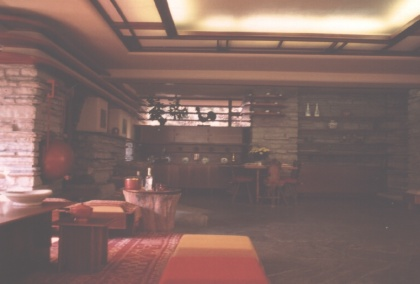| Frank Lloyd Wright's "Fallingwater" | |||
|
But why is the deflection of that portion of the house which is cantilevered over the stream now noticeable, and after all these years a problem which has to be addressed? Did it come from errors made by Frank Lloyd Wright? First of all, we must remember that "Fallingwater" was built in 1936. Sixty-four years ago! And, in that length of time, all materials tend to develop what is called "fatigue" and cantilevers deflect, beams deflect; they simply are in the process of wearing out. To the extent of failing? No. But they are not as strong as they were when first installed, certainly. That said, does it totally explain what is now obviously wrong with "Fallingwater?" Robert McCarter explains, "The most serious mistake in the construction of Fallingwater was made by the contractor and engineer in the pouring of this first-floor concrete slab: at Kaufmanns's (the Owner) request the engineers (his engineers) had redrawn Wright's reinforcing plan for the slab, and by their own admission 'put in twice as much steel as was called for on [Wright's] plans'. This excess steel not only added enormous weight to the carefully calculated slab, but was set so close together that the concrete did not properly fill in between the reinforcing bars, causing an actual loss of strength." Also, according to McCarter, the contractor did this: "In building the wooden formwork to hold the concrete while it was setting, the contractor also neglected to include a slight upward curve or 'camber', to compensate for the structurally insignificant and normal slight settling that occurs over time in reinforced concrete that spans or cantilevers. The result of these blunders, of which Wright was unaware at the time they occurred, are the drooping lines of the main cantilever and the cracks in the concrete that have plagued the house since its completion. That Wright's initial design, refined by Glickman and Peters, has been able to easily sustain these added structural loads and construction weaknesses, argues convincingly for the quality of their structural intuition." So, the current smattering of criticism of "Fallingwater" that one hears is hardly well founded. Well, I had never seen "Fallingwater" in the flesh. But then the Frank Lloyd Wright Foundation told me that if I didn't see it before the end of the millennium, my name would be stricken from the records of those having studied under Mr. Wright (joke). At any rate, I decided that the time |
had come. Everyone must make their obligatory visit to their own Mecca eventually: and so I finally went to see "Fallingwater." After paying the money (they did let me in free but not the members of my small family) we were parceled out in groups of twelve and a tour guide was assigned to us. Almost the first words out of the tour guide's mouth was that incredible fable which it seems will never die: "This is Fallingwater, the fantastic house that Frank Lloyd Wright designed in only three hours." The implication of course being that Mr. Wright (forty years after his death) had not been human, that he had been some kind of super angel who descended to earth, waved his arm, and WOW! created the design for Fallingwater in three hours! Everywhere I go I hear this myth repeated over and over... Wasn't Frank Lloyd Wright enough of a genius? (A famous historian once said, "If I had to limit placing the title of 'genius' on just one man who lived in the twentieth century, I would say that man was Frank Lloyd Wright.") Do we have to make him superhuman, too? No! Fallingwater is great enough of a building that we can feel comfortable in realizing that Frank Lloyd Wright took many more than any three hours to create it, that he took days and days of thought, and many hours drawing perspectives of the house from various positions, studying the proportions in this way--and visualizing it in his mind--before he settled upon the final configuration. (In one such sketch perspective showing the house different from its final plan which Mr. Wright drew in those three hours, the terraces to the left, the west, were not even designed at all. This shows in the photo on page 212 in Robert McCarter's book, "Frank Lloyd Wright.") The fact that his apprentices at the time were not aware that Mr. Wright had done extensive work on the design, before the famous day Mr. Kaufmann called and said he was coming to see the plans, means nothing; for Frank Lloyd Wright often worked on projects in the privacy of his quarters (at both Taliesin's) and then brought the finished conception out to show to everyone, "astounding" them with a design they had known nothing about and one he seemed to have done so quickly. And so, back on that bridge over the stream which leads to the house, to "Fallingwater." The view of the cantilevered balconies from the bridge is a magnificent abstract of line and mass and form, with the waterfall beyond and the stream coursing below and the steps from the house descending to that stream. |
||
 |
|||
| 1 2 3 4 | |||
